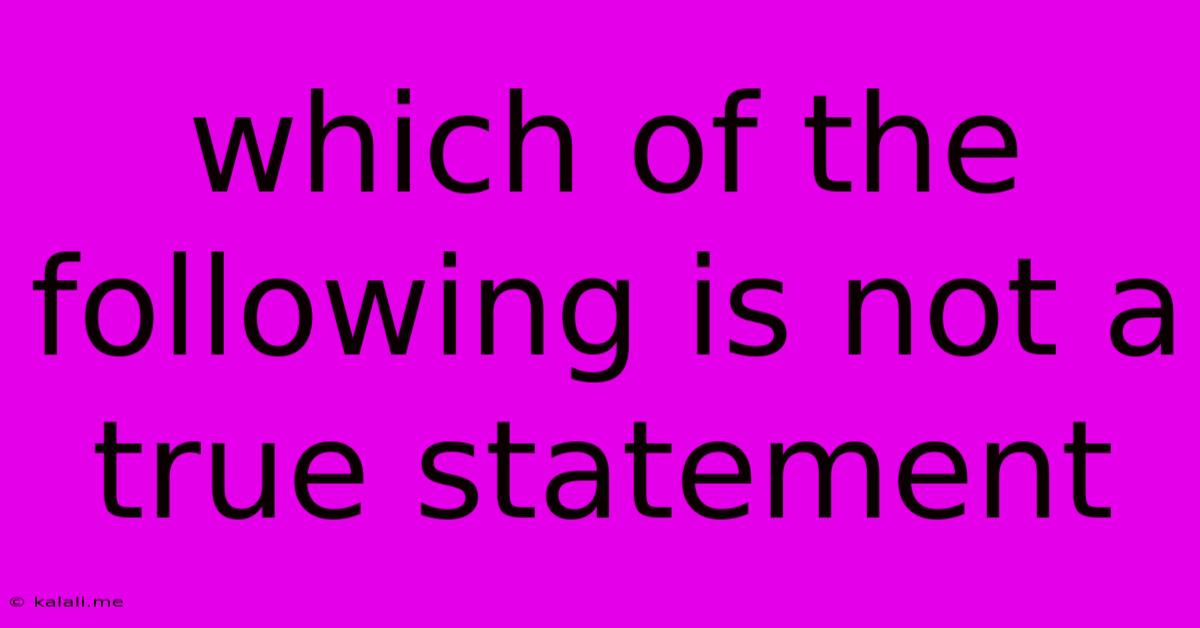Which Of The Following Is Not A True Statement
Kalali
Jun 12, 2025 · 3 min read

Table of Contents
Which of the Following is NOT a True Statement? A Guide to Identifying Falsehoods
This article explores the crucial skill of identifying false statements, a skill vital in various aspects of life, from everyday decision-making to critical analysis of information. We'll delve into common logical fallacies and techniques to help you discern truth from falsehood, ultimately improving your critical thinking abilities. This is particularly important in today's age of misinformation and the rapid spread of false narratives online. Understanding how to identify inaccurate statements will help you navigate the digital landscape more effectively and make better-informed decisions.
Understanding the Nature of False Statements
Before we tackle specific examples, it's essential to understand what constitutes a false statement. A false statement is a claim that is not in accordance with reality. This can range from minor inaccuracies to deliberate falsehoods (lies) and misleading information. Identifying these statements requires careful scrutiny and understanding of several key factors:
- Factual Accuracy: Does the statement align with verifiable facts and evidence? Can you find credible sources that support or refute the claim?
- Logical Consistency: Does the statement follow logically from the presented evidence? Are there any contradictions or inconsistencies within the statement itself or in relation to other known information?
- Source Credibility: Is the source of the statement reliable and trustworthy? Consider the source's expertise, potential biases, and track record of accuracy.
- Contextual Understanding: Is the statement taken out of context? Does the meaning change depending on the surrounding information?
Common Types of False Statements
False statements often stem from logical fallacies, errors in reasoning that lead to invalid conclusions. Here are a few common examples:
- Hasty Generalization: Drawing a broad conclusion based on limited evidence. For example, "I met two rude people from City X, therefore everyone from City X is rude."
- False Dilemma (Either/Or Fallacy): Presenting only two options when more exist. For example, "You're either with us or against us."
- Appeal to Authority: Claiming something is true simply because an authority figure said so, without providing further evidence.
- Appeal to Emotion: Manipulating emotions to persuade rather than using logic and reason.
- Straw Man Fallacy: Misrepresenting an opponent's argument to make it easier to attack.
- Ad Hominem: Attacking the person making the argument instead of addressing the argument itself.
Strategies for Identifying False Statements
Several strategies can help you pinpoint false statements:
- Question Everything: Approach claims with healthy skepticism. Don't accept information at face value.
- Verify Information: Check the source's credibility and look for corroborating evidence from multiple independent sources.
- Identify Logical Fallacies: Be aware of common logical fallacies and how they're used to mislead.
- Consider Alternative Explanations: Explore different perspectives and interpretations.
- Look for Bias: Be aware of potential biases in the information presented.
Conclusion: Cultivating Critical Thinking
The ability to distinguish between true and false statements is a fundamental aspect of critical thinking. By understanding the nature of false statements, recognizing common logical fallacies, and employing effective identification strategies, you can significantly improve your ability to evaluate information critically and make well-informed decisions in all aspects of your life. This skill is more crucial than ever in our current information-saturated world, enabling you to navigate the complexities of modern life with greater confidence and discernment. Remember, continuous learning and practice are key to honing your critical thinking skills.
Latest Posts
Latest Posts
-
Which Of The Following Is An Example Of Disinfection
Jun 13, 2025
-
Difference Between A Quota And A Tariff
Jun 13, 2025
-
Which Chamber Of The Heart Has The Thickest Muscular Wall
Jun 13, 2025
-
Reactvity With A Base A Physical Or Chemical Property
Jun 13, 2025
-
Difference Between Square And A Rhombus
Jun 13, 2025
Related Post
Thank you for visiting our website which covers about Which Of The Following Is Not A True Statement . We hope the information provided has been useful to you. Feel free to contact us if you have any questions or need further assistance. See you next time and don't miss to bookmark.